Marketing Report: Organic Vegetable Business of John Beckett
VerifiedAdded on 2022/09/11
|15
|5216
|18
Report
AI Summary
This report provides a comprehensive marketing analysis for John Beckett's organic vegetable business. It begins with an introduction to the importance of effective marketing for SMEs, particularly in the organic food sector. The report examines the internal and external business environment, including a SWOT analysis to identify strengths, weaknesses, opportunities, and threats. It then details the marketing mix (product, price, place, and promotion) and suggests appropriate Porter's generic strategies (cost leadership and focus differentiation) to gain a competitive advantage. The report also explores potential innovations, such as digital marketing and app-based sales, to enhance business performance. A PESTLE analysis provides insights into the external factors impacting the business. The report concludes with recommendations for targeting the market for sustainable growth and suggests various strategies John Beckett can implement to improve his business. The report is supported by relevant references to academic sources.
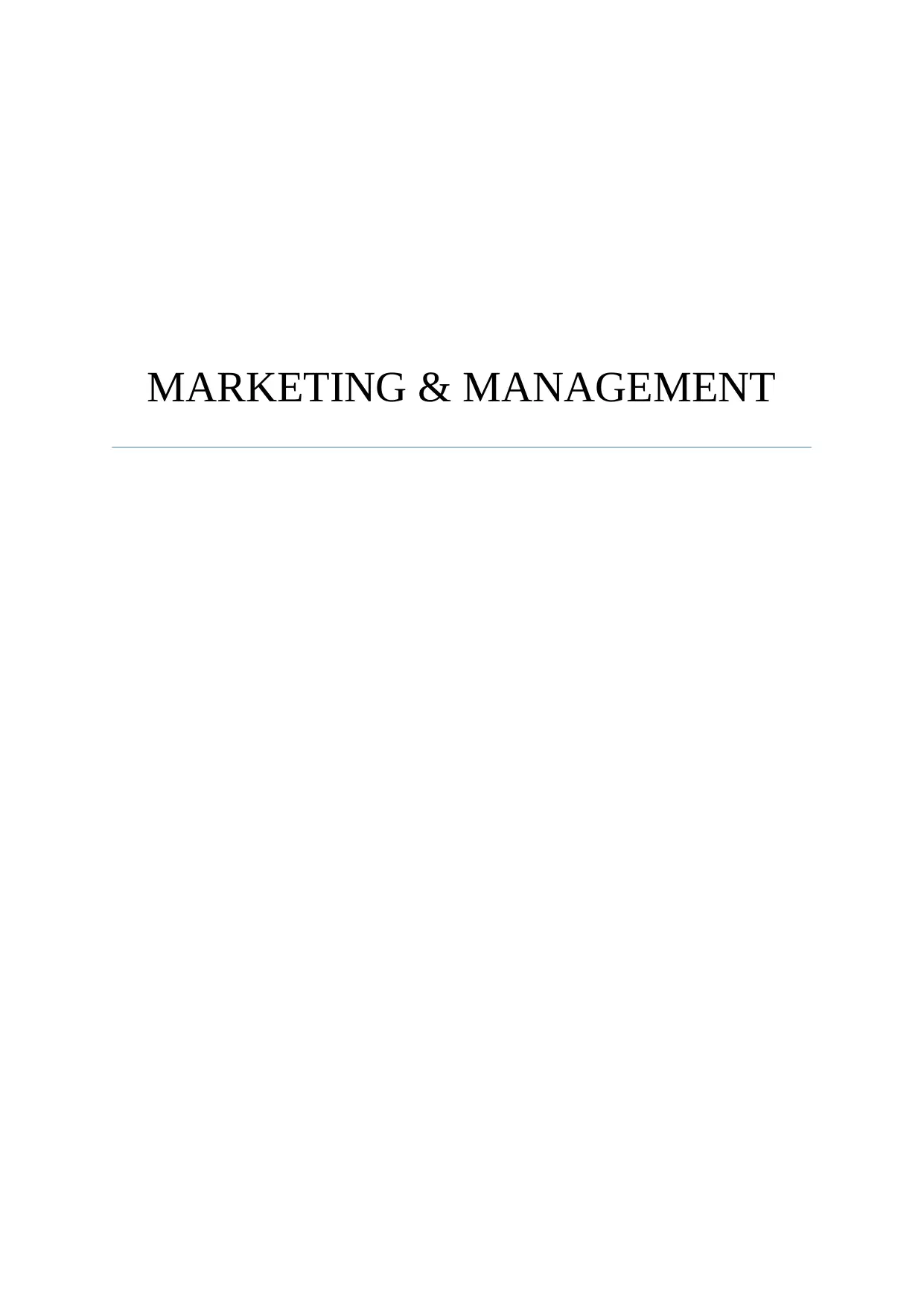
MARKETING & MANAGEMENT
Paraphrase This Document
Need a fresh take? Get an instant paraphrase of this document with our AI Paraphraser
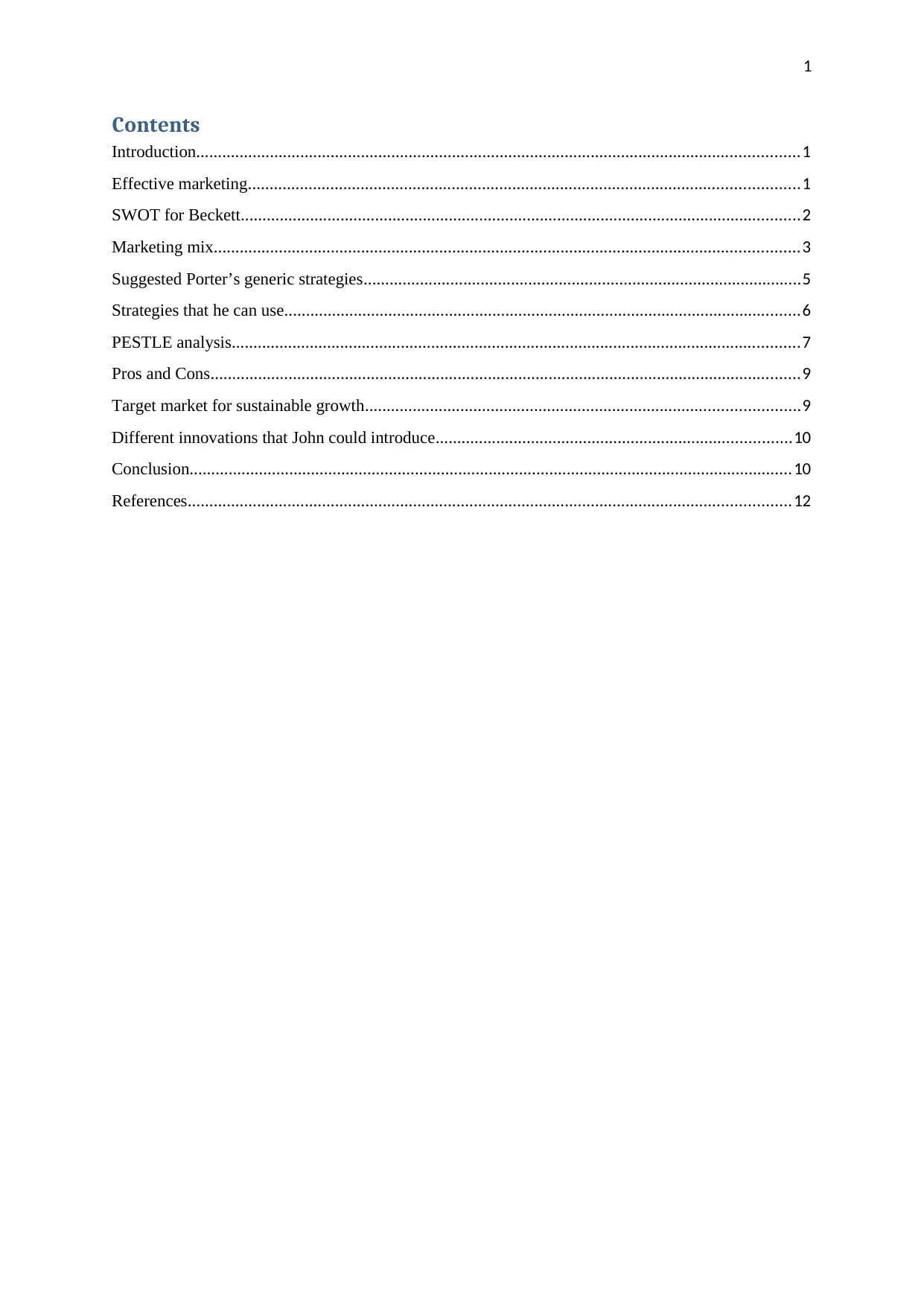
1
Contents
Introduction...........................................................................................................................................1
Effective marketing...............................................................................................................................1
SWOT for Beckett.................................................................................................................................2
Marketing mix.......................................................................................................................................3
Suggested Porter’s generic strategies.....................................................................................................5
Strategies that he can use.......................................................................................................................6
PESTLE analysis...................................................................................................................................7
Pros and Cons........................................................................................................................................9
Target market for sustainable growth....................................................................................................9
Different innovations that John could introduce..................................................................................10
Conclusion...........................................................................................................................................10
References...........................................................................................................................................12
Contents
Introduction...........................................................................................................................................1
Effective marketing...............................................................................................................................1
SWOT for Beckett.................................................................................................................................2
Marketing mix.......................................................................................................................................3
Suggested Porter’s generic strategies.....................................................................................................5
Strategies that he can use.......................................................................................................................6
PESTLE analysis...................................................................................................................................7
Pros and Cons........................................................................................................................................9
Target market for sustainable growth....................................................................................................9
Different innovations that John could introduce..................................................................................10
Conclusion...........................................................................................................................................10
References...........................................................................................................................................12
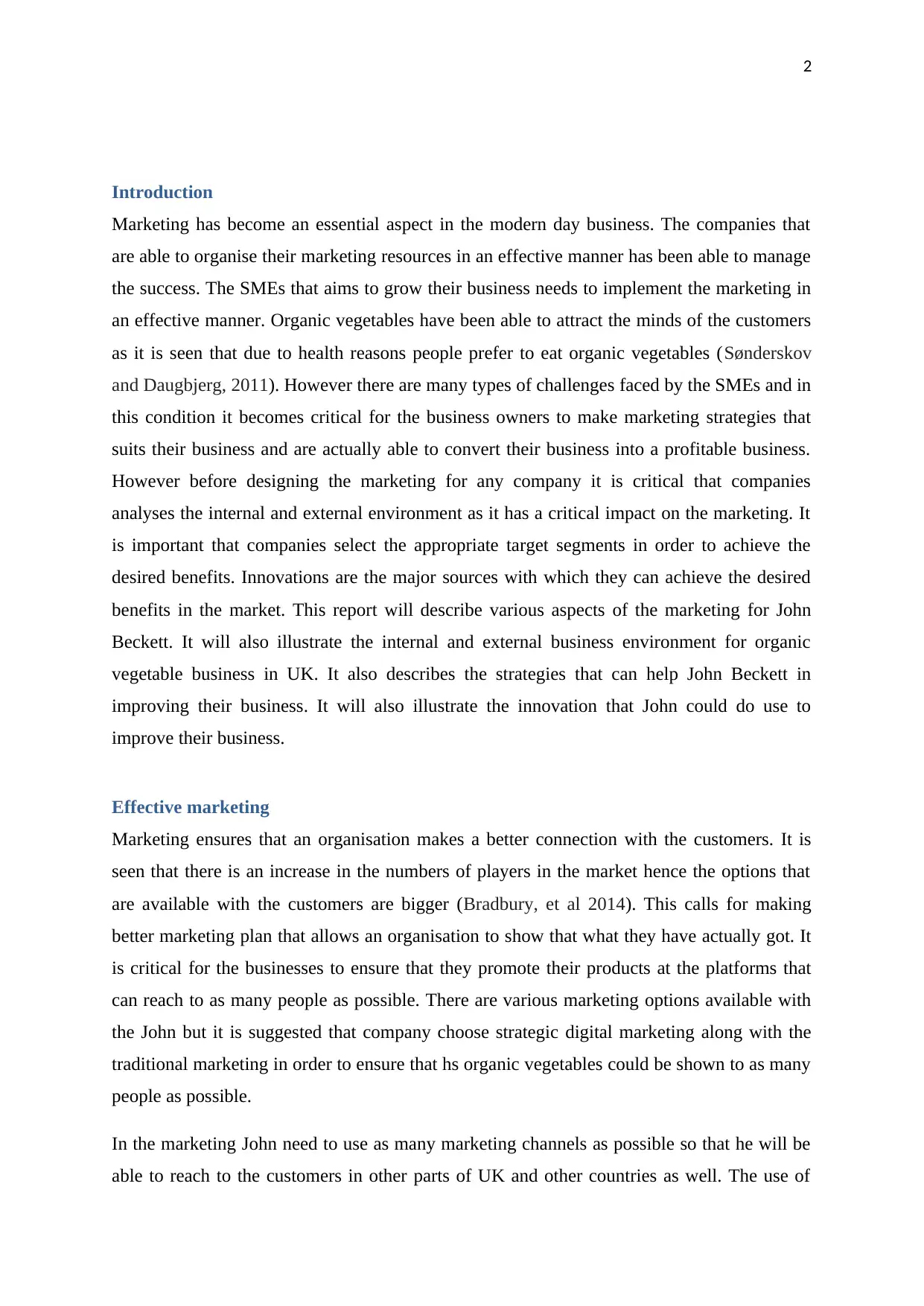
2
Introduction
Marketing has become an essential aspect in the modern day business. The companies that
are able to organise their marketing resources in an effective manner has been able to manage
the success. The SMEs that aims to grow their business needs to implement the marketing in
an effective manner. Organic vegetables have been able to attract the minds of the customers
as it is seen that due to health reasons people prefer to eat organic vegetables (Sønderskov
and Daugbjerg, 2011). However there are many types of challenges faced by the SMEs and in
this condition it becomes critical for the business owners to make marketing strategies that
suits their business and are actually able to convert their business into a profitable business.
However before designing the marketing for any company it is critical that companies
analyses the internal and external environment as it has a critical impact on the marketing. It
is important that companies select the appropriate target segments in order to achieve the
desired benefits. Innovations are the major sources with which they can achieve the desired
benefits in the market. This report will describe various aspects of the marketing for John
Beckett. It will also illustrate the internal and external business environment for organic
vegetable business in UK. It also describes the strategies that can help John Beckett in
improving their business. It will also illustrate the innovation that John could do use to
improve their business.
Effective marketing
Marketing ensures that an organisation makes a better connection with the customers. It is
seen that there is an increase in the numbers of players in the market hence the options that
are available with the customers are bigger (Bradbury, et al 2014). This calls for making
better marketing plan that allows an organisation to show that what they have actually got. It
is critical for the businesses to ensure that they promote their products at the platforms that
can reach to as many people as possible. There are various marketing options available with
the John but it is suggested that company choose strategic digital marketing along with the
traditional marketing in order to ensure that hs organic vegetables could be shown to as many
people as possible.
In the marketing John need to use as many marketing channels as possible so that he will be
able to reach to the customers in other parts of UK and other countries as well. The use of
Introduction
Marketing has become an essential aspect in the modern day business. The companies that
are able to organise their marketing resources in an effective manner has been able to manage
the success. The SMEs that aims to grow their business needs to implement the marketing in
an effective manner. Organic vegetables have been able to attract the minds of the customers
as it is seen that due to health reasons people prefer to eat organic vegetables (Sønderskov
and Daugbjerg, 2011). However there are many types of challenges faced by the SMEs and in
this condition it becomes critical for the business owners to make marketing strategies that
suits their business and are actually able to convert their business into a profitable business.
However before designing the marketing for any company it is critical that companies
analyses the internal and external environment as it has a critical impact on the marketing. It
is important that companies select the appropriate target segments in order to achieve the
desired benefits. Innovations are the major sources with which they can achieve the desired
benefits in the market. This report will describe various aspects of the marketing for John
Beckett. It will also illustrate the internal and external business environment for organic
vegetable business in UK. It also describes the strategies that can help John Beckett in
improving their business. It will also illustrate the innovation that John could do use to
improve their business.
Effective marketing
Marketing ensures that an organisation makes a better connection with the customers. It is
seen that there is an increase in the numbers of players in the market hence the options that
are available with the customers are bigger (Bradbury, et al 2014). This calls for making
better marketing plan that allows an organisation to show that what they have actually got. It
is critical for the businesses to ensure that they promote their products at the platforms that
can reach to as many people as possible. There are various marketing options available with
the John but it is suggested that company choose strategic digital marketing along with the
traditional marketing in order to ensure that hs organic vegetables could be shown to as many
people as possible.
In the marketing John need to use as many marketing channels as possible so that he will be
able to reach to the customers in other parts of UK and other countries as well. The use of
⊘ This is a preview!⊘
Do you want full access?
Subscribe today to unlock all pages.

Trusted by 1+ million students worldwide
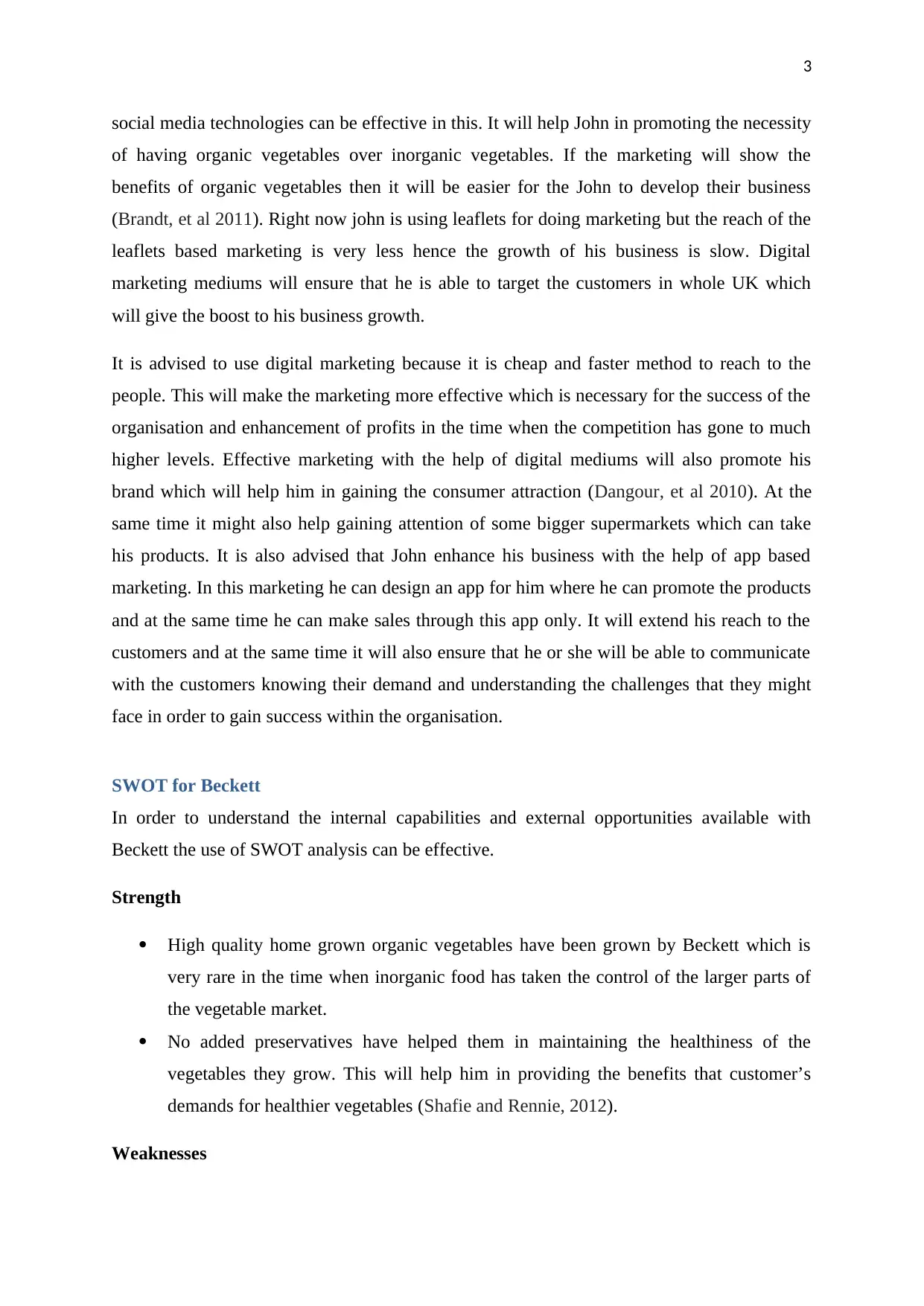
3
social media technologies can be effective in this. It will help John in promoting the necessity
of having organic vegetables over inorganic vegetables. If the marketing will show the
benefits of organic vegetables then it will be easier for the John to develop their business
(Brandt, et al 2011). Right now john is using leaflets for doing marketing but the reach of the
leaflets based marketing is very less hence the growth of his business is slow. Digital
marketing mediums will ensure that he is able to target the customers in whole UK which
will give the boost to his business growth.
It is advised to use digital marketing because it is cheap and faster method to reach to the
people. This will make the marketing more effective which is necessary for the success of the
organisation and enhancement of profits in the time when the competition has gone to much
higher levels. Effective marketing with the help of digital mediums will also promote his
brand which will help him in gaining the consumer attraction (Dangour, et al 2010). At the
same time it might also help gaining attention of some bigger supermarkets which can take
his products. It is also advised that John enhance his business with the help of app based
marketing. In this marketing he can design an app for him where he can promote the products
and at the same time he can make sales through this app only. It will extend his reach to the
customers and at the same time it will also ensure that he or she will be able to communicate
with the customers knowing their demand and understanding the challenges that they might
face in order to gain success within the organisation.
SWOT for Beckett
In order to understand the internal capabilities and external opportunities available with
Beckett the use of SWOT analysis can be effective.
Strength
High quality home grown organic vegetables have been grown by Beckett which is
very rare in the time when inorganic food has taken the control of the larger parts of
the vegetable market.
No added preservatives have helped them in maintaining the healthiness of the
vegetables they grow. This will help him in providing the benefits that customer’s
demands for healthier vegetables (Shafie and Rennie, 2012).
Weaknesses
social media technologies can be effective in this. It will help John in promoting the necessity
of having organic vegetables over inorganic vegetables. If the marketing will show the
benefits of organic vegetables then it will be easier for the John to develop their business
(Brandt, et al 2011). Right now john is using leaflets for doing marketing but the reach of the
leaflets based marketing is very less hence the growth of his business is slow. Digital
marketing mediums will ensure that he is able to target the customers in whole UK which
will give the boost to his business growth.
It is advised to use digital marketing because it is cheap and faster method to reach to the
people. This will make the marketing more effective which is necessary for the success of the
organisation and enhancement of profits in the time when the competition has gone to much
higher levels. Effective marketing with the help of digital mediums will also promote his
brand which will help him in gaining the consumer attraction (Dangour, et al 2010). At the
same time it might also help gaining attention of some bigger supermarkets which can take
his products. It is also advised that John enhance his business with the help of app based
marketing. In this marketing he can design an app for him where he can promote the products
and at the same time he can make sales through this app only. It will extend his reach to the
customers and at the same time it will also ensure that he or she will be able to communicate
with the customers knowing their demand and understanding the challenges that they might
face in order to gain success within the organisation.
SWOT for Beckett
In order to understand the internal capabilities and external opportunities available with
Beckett the use of SWOT analysis can be effective.
Strength
High quality home grown organic vegetables have been grown by Beckett which is
very rare in the time when inorganic food has taken the control of the larger parts of
the vegetable market.
No added preservatives have helped them in maintaining the healthiness of the
vegetables they grow. This will help him in providing the benefits that customer’s
demands for healthier vegetables (Shafie and Rennie, 2012).
Weaknesses
Paraphrase This Document
Need a fresh take? Get an instant paraphrase of this document with our AI Paraphraser
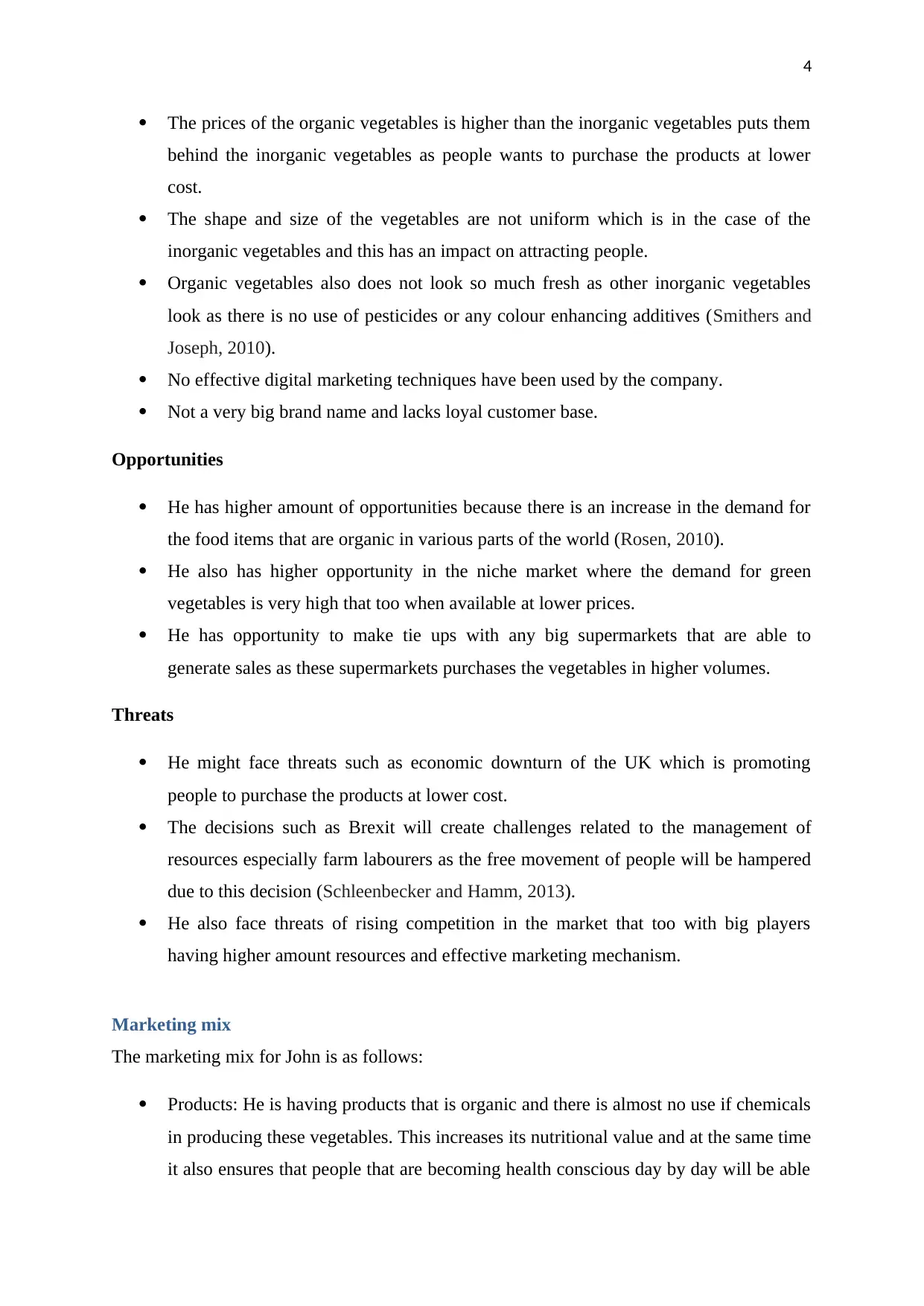
4
The prices of the organic vegetables is higher than the inorganic vegetables puts them
behind the inorganic vegetables as people wants to purchase the products at lower
cost.
The shape and size of the vegetables are not uniform which is in the case of the
inorganic vegetables and this has an impact on attracting people.
Organic vegetables also does not look so much fresh as other inorganic vegetables
look as there is no use of pesticides or any colour enhancing additives (Smithers and
Joseph, 2010).
No effective digital marketing techniques have been used by the company.
Not a very big brand name and lacks loyal customer base.
Opportunities
He has higher amount of opportunities because there is an increase in the demand for
the food items that are organic in various parts of the world (Rosen, 2010).
He also has higher opportunity in the niche market where the demand for green
vegetables is very high that too when available at lower prices.
He has opportunity to make tie ups with any big supermarkets that are able to
generate sales as these supermarkets purchases the vegetables in higher volumes.
Threats
He might face threats such as economic downturn of the UK which is promoting
people to purchase the products at lower cost.
The decisions such as Brexit will create challenges related to the management of
resources especially farm labourers as the free movement of people will be hampered
due to this decision (Schleenbecker and Hamm, 2013).
He also face threats of rising competition in the market that too with big players
having higher amount resources and effective marketing mechanism.
Marketing mix
The marketing mix for John is as follows:
Products: He is having products that is organic and there is almost no use if chemicals
in producing these vegetables. This increases its nutritional value and at the same time
it also ensures that people that are becoming health conscious day by day will be able
The prices of the organic vegetables is higher than the inorganic vegetables puts them
behind the inorganic vegetables as people wants to purchase the products at lower
cost.
The shape and size of the vegetables are not uniform which is in the case of the
inorganic vegetables and this has an impact on attracting people.
Organic vegetables also does not look so much fresh as other inorganic vegetables
look as there is no use of pesticides or any colour enhancing additives (Smithers and
Joseph, 2010).
No effective digital marketing techniques have been used by the company.
Not a very big brand name and lacks loyal customer base.
Opportunities
He has higher amount of opportunities because there is an increase in the demand for
the food items that are organic in various parts of the world (Rosen, 2010).
He also has higher opportunity in the niche market where the demand for green
vegetables is very high that too when available at lower prices.
He has opportunity to make tie ups with any big supermarkets that are able to
generate sales as these supermarkets purchases the vegetables in higher volumes.
Threats
He might face threats such as economic downturn of the UK which is promoting
people to purchase the products at lower cost.
The decisions such as Brexit will create challenges related to the management of
resources especially farm labourers as the free movement of people will be hampered
due to this decision (Schleenbecker and Hamm, 2013).
He also face threats of rising competition in the market that too with big players
having higher amount resources and effective marketing mechanism.
Marketing mix
The marketing mix for John is as follows:
Products: He is having products that is organic and there is almost no use if chemicals
in producing these vegetables. This increases its nutritional value and at the same time
it also ensures that people that are becoming health conscious day by day will be able
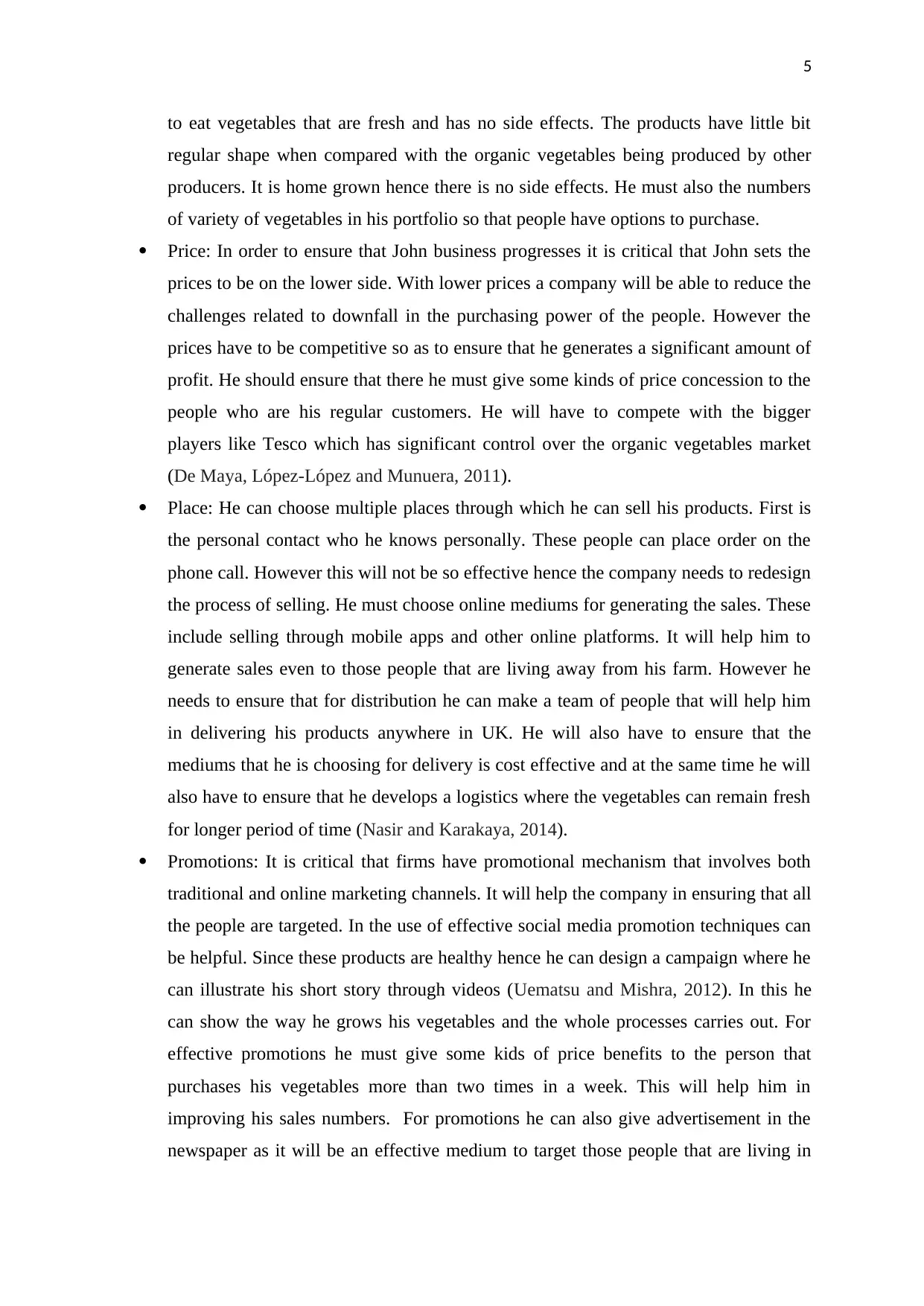
5
to eat vegetables that are fresh and has no side effects. The products have little bit
regular shape when compared with the organic vegetables being produced by other
producers. It is home grown hence there is no side effects. He must also the numbers
of variety of vegetables in his portfolio so that people have options to purchase.
Price: In order to ensure that John business progresses it is critical that John sets the
prices to be on the lower side. With lower prices a company will be able to reduce the
challenges related to downfall in the purchasing power of the people. However the
prices have to be competitive so as to ensure that he generates a significant amount of
profit. He should ensure that there he must give some kinds of price concession to the
people who are his regular customers. He will have to compete with the bigger
players like Tesco which has significant control over the organic vegetables market
(De Maya, López-López and Munuera, 2011).
Place: He can choose multiple places through which he can sell his products. First is
the personal contact who he knows personally. These people can place order on the
phone call. However this will not be so effective hence the company needs to redesign
the process of selling. He must choose online mediums for generating the sales. These
include selling through mobile apps and other online platforms. It will help him to
generate sales even to those people that are living away from his farm. However he
needs to ensure that for distribution he can make a team of people that will help him
in delivering his products anywhere in UK. He will also have to ensure that the
mediums that he is choosing for delivery is cost effective and at the same time he will
also have to ensure that he develops a logistics where the vegetables can remain fresh
for longer period of time (Nasir and Karakaya, 2014).
Promotions: It is critical that firms have promotional mechanism that involves both
traditional and online marketing channels. It will help the company in ensuring that all
the people are targeted. In the use of effective social media promotion techniques can
be helpful. Since these products are healthy hence he can design a campaign where he
can illustrate his short story through videos (Uematsu and Mishra, 2012). In this he
can show the way he grows his vegetables and the whole processes carries out. For
effective promotions he must give some kids of price benefits to the person that
purchases his vegetables more than two times in a week. This will help him in
improving his sales numbers. For promotions he can also give advertisement in the
newspaper as it will be an effective medium to target those people that are living in
to eat vegetables that are fresh and has no side effects. The products have little bit
regular shape when compared with the organic vegetables being produced by other
producers. It is home grown hence there is no side effects. He must also the numbers
of variety of vegetables in his portfolio so that people have options to purchase.
Price: In order to ensure that John business progresses it is critical that John sets the
prices to be on the lower side. With lower prices a company will be able to reduce the
challenges related to downfall in the purchasing power of the people. However the
prices have to be competitive so as to ensure that he generates a significant amount of
profit. He should ensure that there he must give some kinds of price concession to the
people who are his regular customers. He will have to compete with the bigger
players like Tesco which has significant control over the organic vegetables market
(De Maya, López-López and Munuera, 2011).
Place: He can choose multiple places through which he can sell his products. First is
the personal contact who he knows personally. These people can place order on the
phone call. However this will not be so effective hence the company needs to redesign
the process of selling. He must choose online mediums for generating the sales. These
include selling through mobile apps and other online platforms. It will help him to
generate sales even to those people that are living away from his farm. However he
needs to ensure that for distribution he can make a team of people that will help him
in delivering his products anywhere in UK. He will also have to ensure that the
mediums that he is choosing for delivery is cost effective and at the same time he will
also have to ensure that he develops a logistics where the vegetables can remain fresh
for longer period of time (Nasir and Karakaya, 2014).
Promotions: It is critical that firms have promotional mechanism that involves both
traditional and online marketing channels. It will help the company in ensuring that all
the people are targeted. In the use of effective social media promotion techniques can
be helpful. Since these products are healthy hence he can design a campaign where he
can illustrate his short story through videos (Uematsu and Mishra, 2012). In this he
can show the way he grows his vegetables and the whole processes carries out. For
effective promotions he must give some kids of price benefits to the person that
purchases his vegetables more than two times in a week. This will help him in
improving his sales numbers. For promotions he can also give advertisement in the
newspaper as it will be an effective medium to target those people that are living in
⊘ This is a preview!⊘
Do you want full access?
Subscribe today to unlock all pages.

Trusted by 1+ million students worldwide
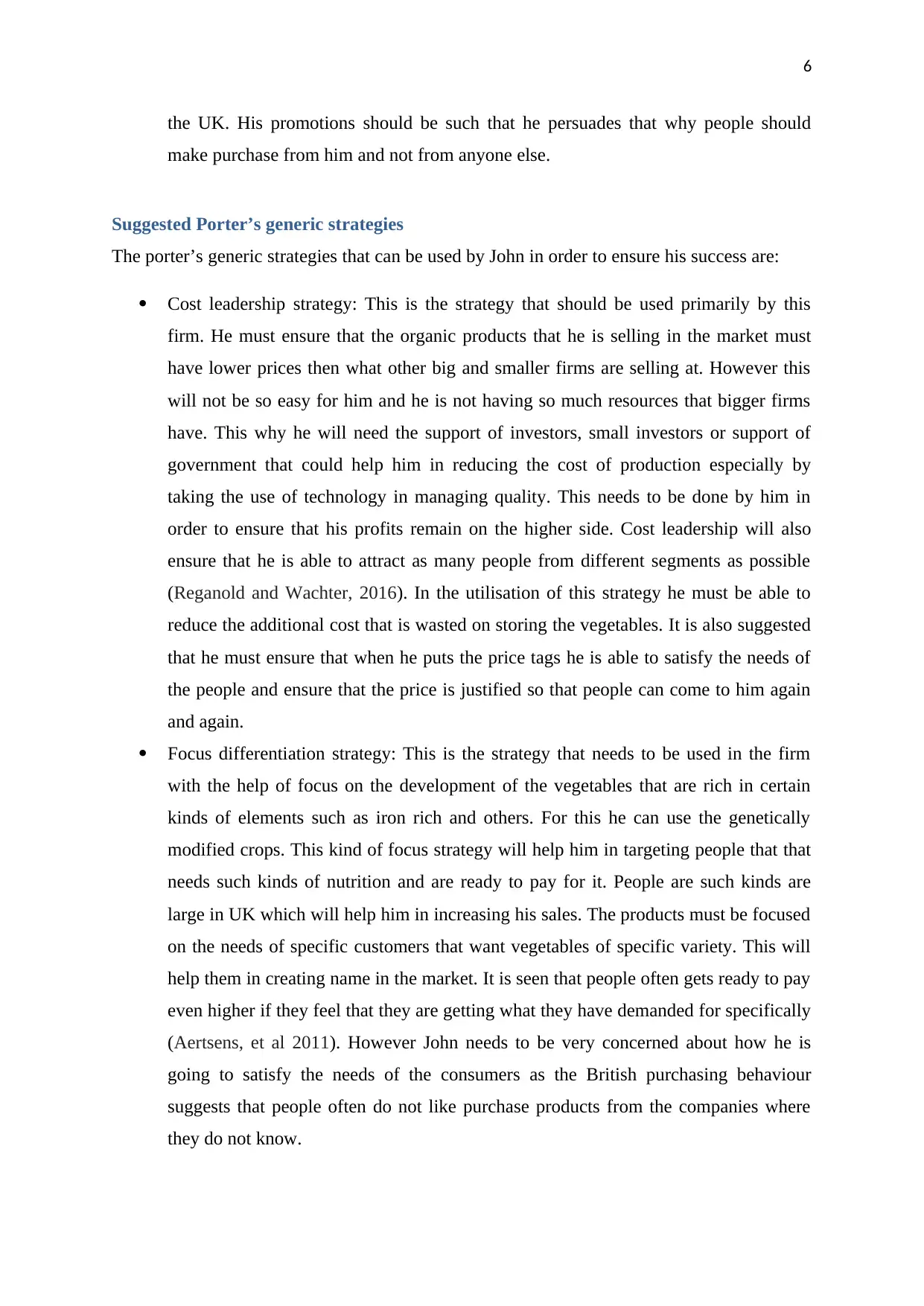
6
the UK. His promotions should be such that he persuades that why people should
make purchase from him and not from anyone else.
Suggested Porter’s generic strategies
The porter’s generic strategies that can be used by John in order to ensure his success are:
Cost leadership strategy: This is the strategy that should be used primarily by this
firm. He must ensure that the organic products that he is selling in the market must
have lower prices then what other big and smaller firms are selling at. However this
will not be so easy for him and he is not having so much resources that bigger firms
have. This why he will need the support of investors, small investors or support of
government that could help him in reducing the cost of production especially by
taking the use of technology in managing quality. This needs to be done by him in
order to ensure that his profits remain on the higher side. Cost leadership will also
ensure that he is able to attract as many people from different segments as possible
(Reganold and Wachter, 2016). In the utilisation of this strategy he must be able to
reduce the additional cost that is wasted on storing the vegetables. It is also suggested
that he must ensure that when he puts the price tags he is able to satisfy the needs of
the people and ensure that the price is justified so that people can come to him again
and again.
Focus differentiation strategy: This is the strategy that needs to be used in the firm
with the help of focus on the development of the vegetables that are rich in certain
kinds of elements such as iron rich and others. For this he can use the genetically
modified crops. This kind of focus strategy will help him in targeting people that that
needs such kinds of nutrition and are ready to pay for it. People are such kinds are
large in UK which will help him in increasing his sales. The products must be focused
on the needs of specific customers that want vegetables of specific variety. This will
help them in creating name in the market. It is seen that people often gets ready to pay
even higher if they feel that they are getting what they have demanded for specifically
(Aertsens, et al 2011). However John needs to be very concerned about how he is
going to satisfy the needs of the consumers as the British purchasing behaviour
suggests that people often do not like purchase products from the companies where
they do not know.
the UK. His promotions should be such that he persuades that why people should
make purchase from him and not from anyone else.
Suggested Porter’s generic strategies
The porter’s generic strategies that can be used by John in order to ensure his success are:
Cost leadership strategy: This is the strategy that should be used primarily by this
firm. He must ensure that the organic products that he is selling in the market must
have lower prices then what other big and smaller firms are selling at. However this
will not be so easy for him and he is not having so much resources that bigger firms
have. This why he will need the support of investors, small investors or support of
government that could help him in reducing the cost of production especially by
taking the use of technology in managing quality. This needs to be done by him in
order to ensure that his profits remain on the higher side. Cost leadership will also
ensure that he is able to attract as many people from different segments as possible
(Reganold and Wachter, 2016). In the utilisation of this strategy he must be able to
reduce the additional cost that is wasted on storing the vegetables. It is also suggested
that he must ensure that when he puts the price tags he is able to satisfy the needs of
the people and ensure that the price is justified so that people can come to him again
and again.
Focus differentiation strategy: This is the strategy that needs to be used in the firm
with the help of focus on the development of the vegetables that are rich in certain
kinds of elements such as iron rich and others. For this he can use the genetically
modified crops. This kind of focus strategy will help him in targeting people that that
needs such kinds of nutrition and are ready to pay for it. People are such kinds are
large in UK which will help him in increasing his sales. The products must be focused
on the needs of specific customers that want vegetables of specific variety. This will
help them in creating name in the market. It is seen that people often gets ready to pay
even higher if they feel that they are getting what they have demanded for specifically
(Aertsens, et al 2011). However John needs to be very concerned about how he is
going to satisfy the needs of the consumers as the British purchasing behaviour
suggests that people often do not like purchase products from the companies where
they do not know.
Paraphrase This Document
Need a fresh take? Get an instant paraphrase of this document with our AI Paraphraser
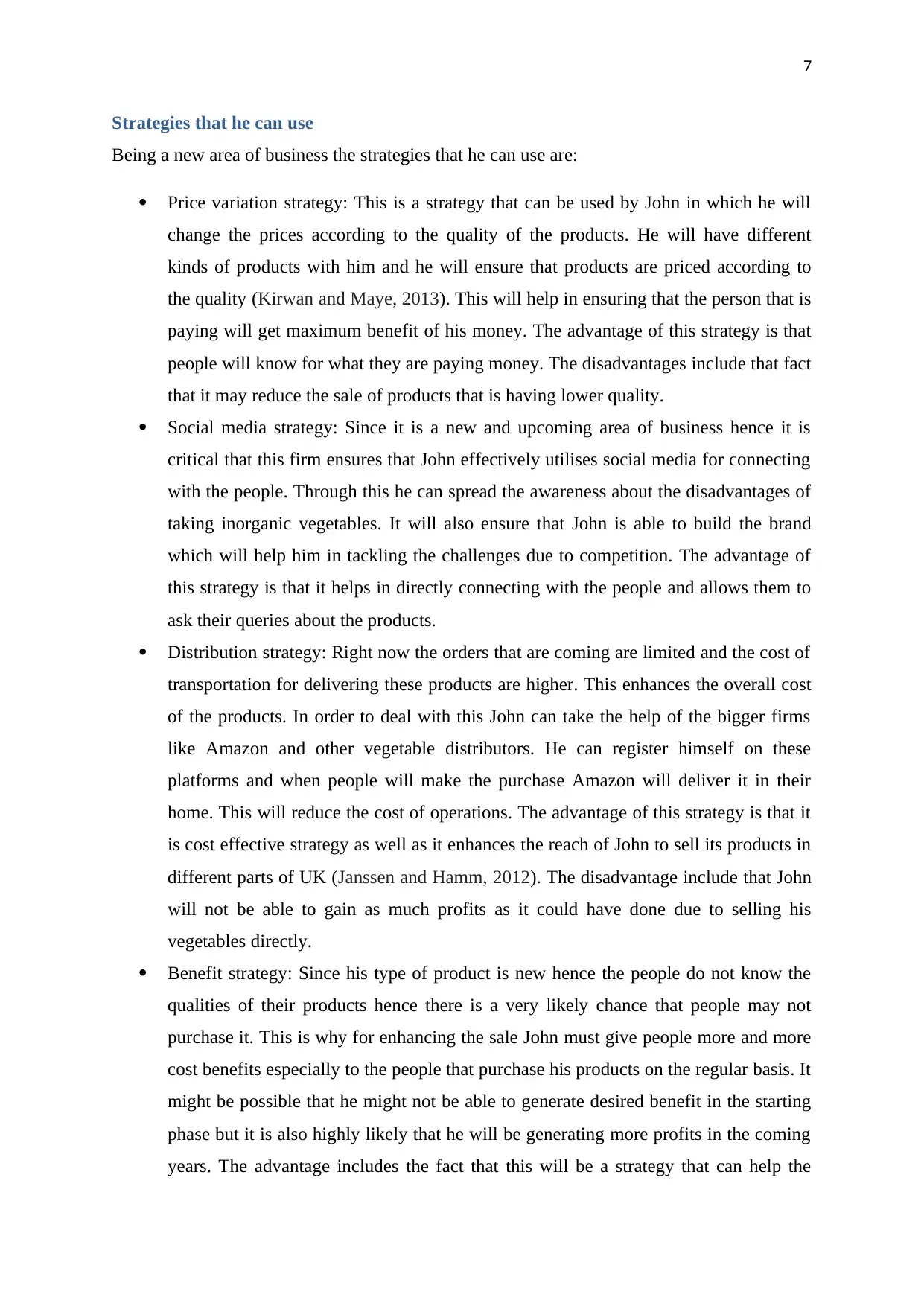
7
Strategies that he can use
Being a new area of business the strategies that he can use are:
Price variation strategy: This is a strategy that can be used by John in which he will
change the prices according to the quality of the products. He will have different
kinds of products with him and he will ensure that products are priced according to
the quality (Kirwan and Maye, 2013). This will help in ensuring that the person that is
paying will get maximum benefit of his money. The advantage of this strategy is that
people will know for what they are paying money. The disadvantages include that fact
that it may reduce the sale of products that is having lower quality.
Social media strategy: Since it is a new and upcoming area of business hence it is
critical that this firm ensures that John effectively utilises social media for connecting
with the people. Through this he can spread the awareness about the disadvantages of
taking inorganic vegetables. It will also ensure that John is able to build the brand
which will help him in tackling the challenges due to competition. The advantage of
this strategy is that it helps in directly connecting with the people and allows them to
ask their queries about the products.
Distribution strategy: Right now the orders that are coming are limited and the cost of
transportation for delivering these products are higher. This enhances the overall cost
of the products. In order to deal with this John can take the help of the bigger firms
like Amazon and other vegetable distributors. He can register himself on these
platforms and when people will make the purchase Amazon will deliver it in their
home. This will reduce the cost of operations. The advantage of this strategy is that it
is cost effective strategy as well as it enhances the reach of John to sell its products in
different parts of UK (Janssen and Hamm, 2012). The disadvantage include that John
will not be able to gain as much profits as it could have done due to selling his
vegetables directly.
Benefit strategy: Since his type of product is new hence the people do not know the
qualities of their products hence there is a very likely chance that people may not
purchase it. This is why for enhancing the sale John must give people more and more
cost benefits especially to the people that purchase his products on the regular basis. It
might be possible that he might not be able to generate desired benefit in the starting
phase but it is also highly likely that he will be generating more profits in the coming
years. The advantage includes the fact that this will be a strategy that can help the
Strategies that he can use
Being a new area of business the strategies that he can use are:
Price variation strategy: This is a strategy that can be used by John in which he will
change the prices according to the quality of the products. He will have different
kinds of products with him and he will ensure that products are priced according to
the quality (Kirwan and Maye, 2013). This will help in ensuring that the person that is
paying will get maximum benefit of his money. The advantage of this strategy is that
people will know for what they are paying money. The disadvantages include that fact
that it may reduce the sale of products that is having lower quality.
Social media strategy: Since it is a new and upcoming area of business hence it is
critical that this firm ensures that John effectively utilises social media for connecting
with the people. Through this he can spread the awareness about the disadvantages of
taking inorganic vegetables. It will also ensure that John is able to build the brand
which will help him in tackling the challenges due to competition. The advantage of
this strategy is that it helps in directly connecting with the people and allows them to
ask their queries about the products.
Distribution strategy: Right now the orders that are coming are limited and the cost of
transportation for delivering these products are higher. This enhances the overall cost
of the products. In order to deal with this John can take the help of the bigger firms
like Amazon and other vegetable distributors. He can register himself on these
platforms and when people will make the purchase Amazon will deliver it in their
home. This will reduce the cost of operations. The advantage of this strategy is that it
is cost effective strategy as well as it enhances the reach of John to sell its products in
different parts of UK (Janssen and Hamm, 2012). The disadvantage include that John
will not be able to gain as much profits as it could have done due to selling his
vegetables directly.
Benefit strategy: Since his type of product is new hence the people do not know the
qualities of their products hence there is a very likely chance that people may not
purchase it. This is why for enhancing the sale John must give people more and more
cost benefits especially to the people that purchase his products on the regular basis. It
might be possible that he might not be able to generate desired benefit in the starting
phase but it is also highly likely that he will be generating more profits in the coming
years. The advantage includes the fact that this will be a strategy that can help the
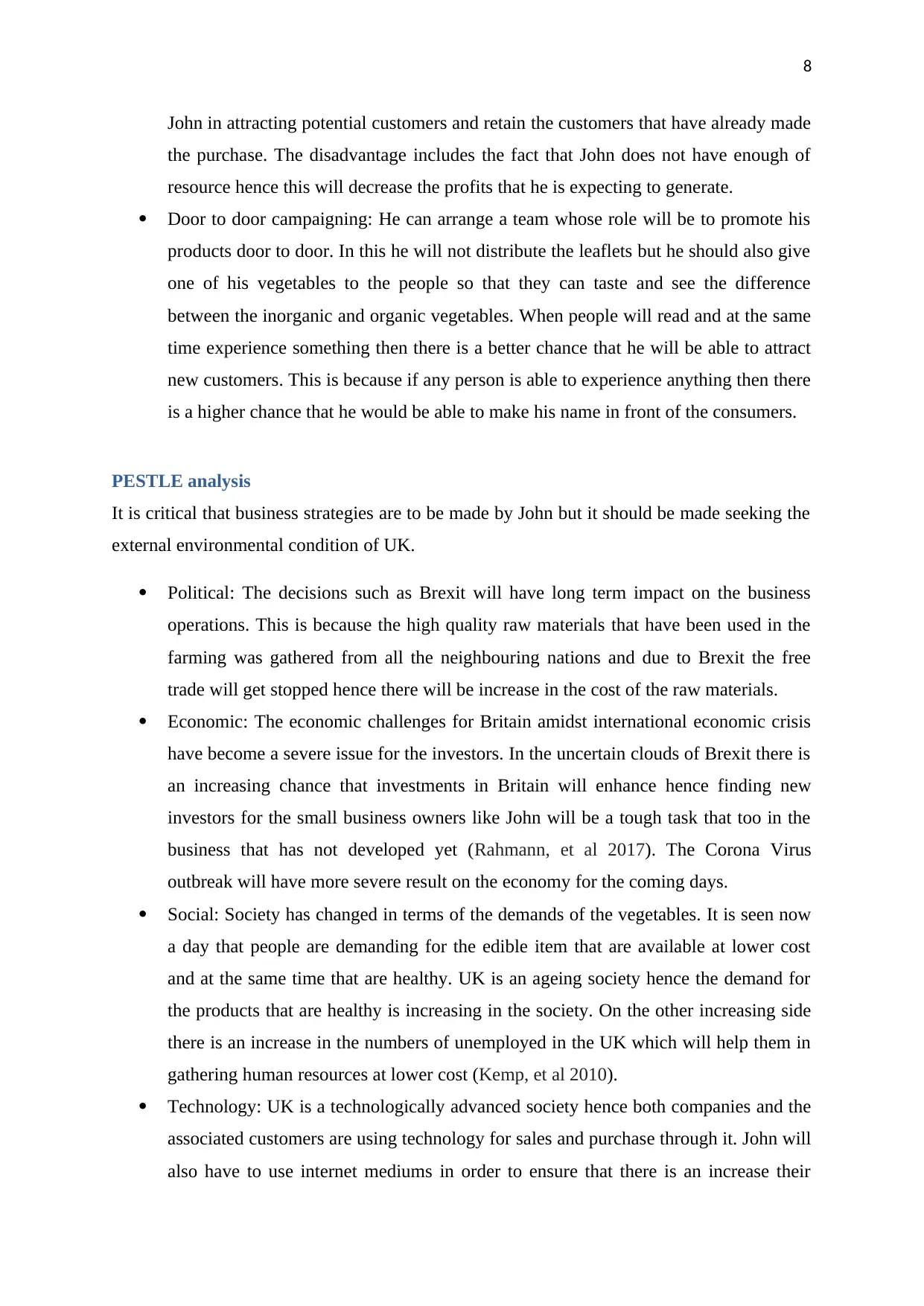
8
John in attracting potential customers and retain the customers that have already made
the purchase. The disadvantage includes the fact that John does not have enough of
resource hence this will decrease the profits that he is expecting to generate.
Door to door campaigning: He can arrange a team whose role will be to promote his
products door to door. In this he will not distribute the leaflets but he should also give
one of his vegetables to the people so that they can taste and see the difference
between the inorganic and organic vegetables. When people will read and at the same
time experience something then there is a better chance that he will be able to attract
new customers. This is because if any person is able to experience anything then there
is a higher chance that he would be able to make his name in front of the consumers.
PESTLE analysis
It is critical that business strategies are to be made by John but it should be made seeking the
external environmental condition of UK.
Political: The decisions such as Brexit will have long term impact on the business
operations. This is because the high quality raw materials that have been used in the
farming was gathered from all the neighbouring nations and due to Brexit the free
trade will get stopped hence there will be increase in the cost of the raw materials.
Economic: The economic challenges for Britain amidst international economic crisis
have become a severe issue for the investors. In the uncertain clouds of Brexit there is
an increasing chance that investments in Britain will enhance hence finding new
investors for the small business owners like John will be a tough task that too in the
business that has not developed yet (Rahmann, et al 2017). The Corona Virus
outbreak will have more severe result on the economy for the coming days.
Social: Society has changed in terms of the demands of the vegetables. It is seen now
a day that people are demanding for the edible item that are available at lower cost
and at the same time that are healthy. UK is an ageing society hence the demand for
the products that are healthy is increasing in the society. On the other increasing side
there is an increase in the numbers of unemployed in the UK which will help them in
gathering human resources at lower cost (Kemp, et al 2010).
Technology: UK is a technologically advanced society hence both companies and the
associated customers are using technology for sales and purchase through it. John will
also have to use internet mediums in order to ensure that there is an increase their
John in attracting potential customers and retain the customers that have already made
the purchase. The disadvantage includes the fact that John does not have enough of
resource hence this will decrease the profits that he is expecting to generate.
Door to door campaigning: He can arrange a team whose role will be to promote his
products door to door. In this he will not distribute the leaflets but he should also give
one of his vegetables to the people so that they can taste and see the difference
between the inorganic and organic vegetables. When people will read and at the same
time experience something then there is a better chance that he will be able to attract
new customers. This is because if any person is able to experience anything then there
is a higher chance that he would be able to make his name in front of the consumers.
PESTLE analysis
It is critical that business strategies are to be made by John but it should be made seeking the
external environmental condition of UK.
Political: The decisions such as Brexit will have long term impact on the business
operations. This is because the high quality raw materials that have been used in the
farming was gathered from all the neighbouring nations and due to Brexit the free
trade will get stopped hence there will be increase in the cost of the raw materials.
Economic: The economic challenges for Britain amidst international economic crisis
have become a severe issue for the investors. In the uncertain clouds of Brexit there is
an increasing chance that investments in Britain will enhance hence finding new
investors for the small business owners like John will be a tough task that too in the
business that has not developed yet (Rahmann, et al 2017). The Corona Virus
outbreak will have more severe result on the economy for the coming days.
Social: Society has changed in terms of the demands of the vegetables. It is seen now
a day that people are demanding for the edible item that are available at lower cost
and at the same time that are healthy. UK is an ageing society hence the demand for
the products that are healthy is increasing in the society. On the other increasing side
there is an increase in the numbers of unemployed in the UK which will help them in
gathering human resources at lower cost (Kemp, et al 2010).
Technology: UK is a technologically advanced society hence both companies and the
associated customers are using technology for sales and purchase through it. John will
also have to use internet mediums in order to ensure that there is an increase their
⊘ This is a preview!⊘
Do you want full access?
Subscribe today to unlock all pages.

Trusted by 1+ million students worldwide
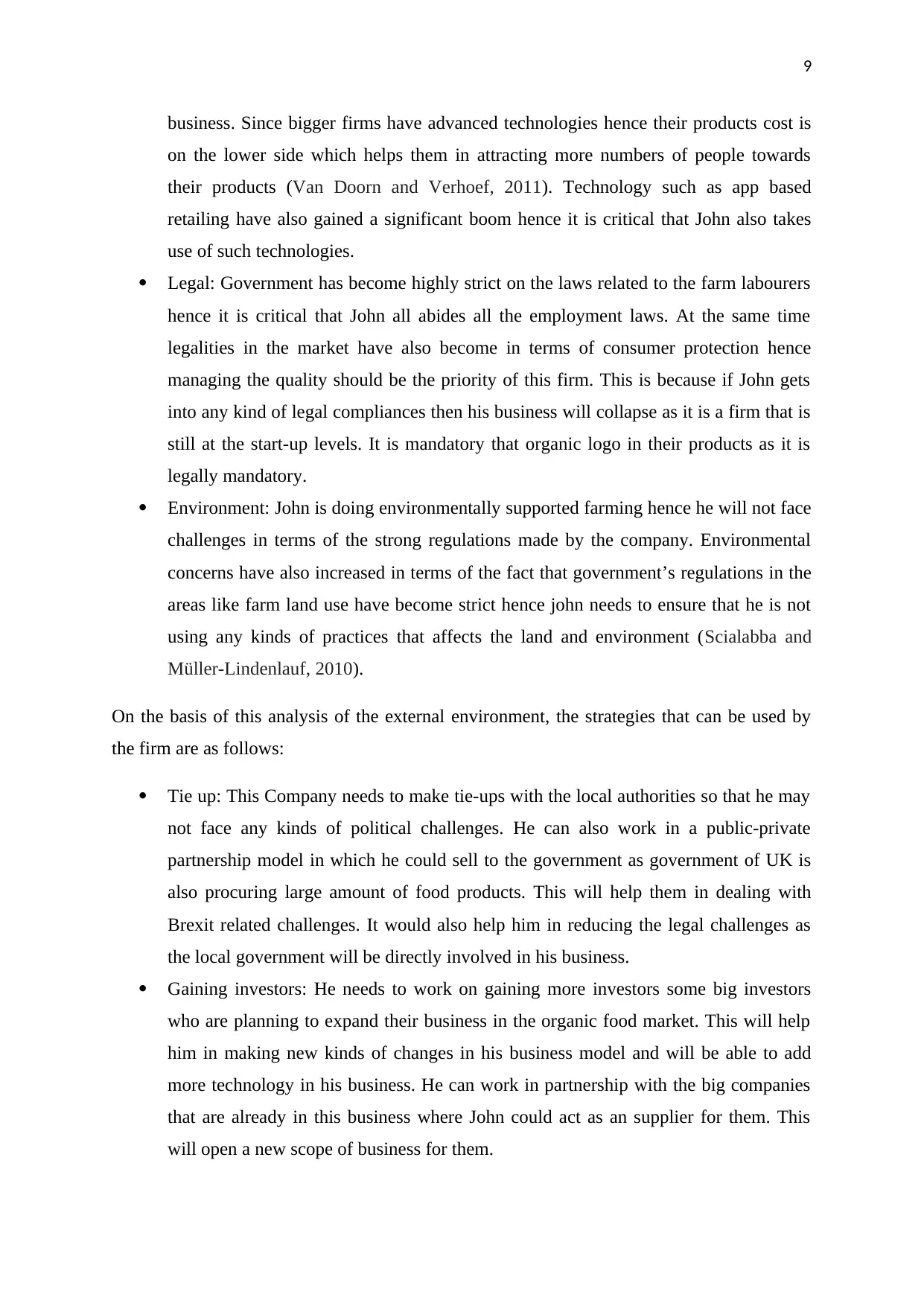
9
business. Since bigger firms have advanced technologies hence their products cost is
on the lower side which helps them in attracting more numbers of people towards
their products (Van Doorn and Verhoef, 2011). Technology such as app based
retailing have also gained a significant boom hence it is critical that John also takes
use of such technologies.
Legal: Government has become highly strict on the laws related to the farm labourers
hence it is critical that John all abides all the employment laws. At the same time
legalities in the market have also become in terms of consumer protection hence
managing the quality should be the priority of this firm. This is because if John gets
into any kind of legal compliances then his business will collapse as it is a firm that is
still at the start-up levels. It is mandatory that organic logo in their products as it is
legally mandatory.
Environment: John is doing environmentally supported farming hence he will not face
challenges in terms of the strong regulations made by the company. Environmental
concerns have also increased in terms of the fact that government’s regulations in the
areas like farm land use have become strict hence john needs to ensure that he is not
using any kinds of practices that affects the land and environment (Scialabba and
Müller-Lindenlauf, 2010).
On the basis of this analysis of the external environment, the strategies that can be used by
the firm are as follows:
Tie up: This Company needs to make tie-ups with the local authorities so that he may
not face any kinds of political challenges. He can also work in a public-private
partnership model in which he could sell to the government as government of UK is
also procuring large amount of food products. This will help them in dealing with
Brexit related challenges. It would also help him in reducing the legal challenges as
the local government will be directly involved in his business.
Gaining investors: He needs to work on gaining more investors some big investors
who are planning to expand their business in the organic food market. This will help
him in making new kinds of changes in his business model and will be able to add
more technology in his business. He can work in partnership with the big companies
that are already in this business where John could act as an supplier for them. This
will open a new scope of business for them.
business. Since bigger firms have advanced technologies hence their products cost is
on the lower side which helps them in attracting more numbers of people towards
their products (Van Doorn and Verhoef, 2011). Technology such as app based
retailing have also gained a significant boom hence it is critical that John also takes
use of such technologies.
Legal: Government has become highly strict on the laws related to the farm labourers
hence it is critical that John all abides all the employment laws. At the same time
legalities in the market have also become in terms of consumer protection hence
managing the quality should be the priority of this firm. This is because if John gets
into any kind of legal compliances then his business will collapse as it is a firm that is
still at the start-up levels. It is mandatory that organic logo in their products as it is
legally mandatory.
Environment: John is doing environmentally supported farming hence he will not face
challenges in terms of the strong regulations made by the company. Environmental
concerns have also increased in terms of the fact that government’s regulations in the
areas like farm land use have become strict hence john needs to ensure that he is not
using any kinds of practices that affects the land and environment (Scialabba and
Müller-Lindenlauf, 2010).
On the basis of this analysis of the external environment, the strategies that can be used by
the firm are as follows:
Tie up: This Company needs to make tie-ups with the local authorities so that he may
not face any kinds of political challenges. He can also work in a public-private
partnership model in which he could sell to the government as government of UK is
also procuring large amount of food products. This will help them in dealing with
Brexit related challenges. It would also help him in reducing the legal challenges as
the local government will be directly involved in his business.
Gaining investors: He needs to work on gaining more investors some big investors
who are planning to expand their business in the organic food market. This will help
him in making new kinds of changes in his business model and will be able to add
more technology in his business. He can work in partnership with the big companies
that are already in this business where John could act as an supplier for them. This
will open a new scope of business for them.
Paraphrase This Document
Need a fresh take? Get an instant paraphrase of this document with our AI Paraphraser
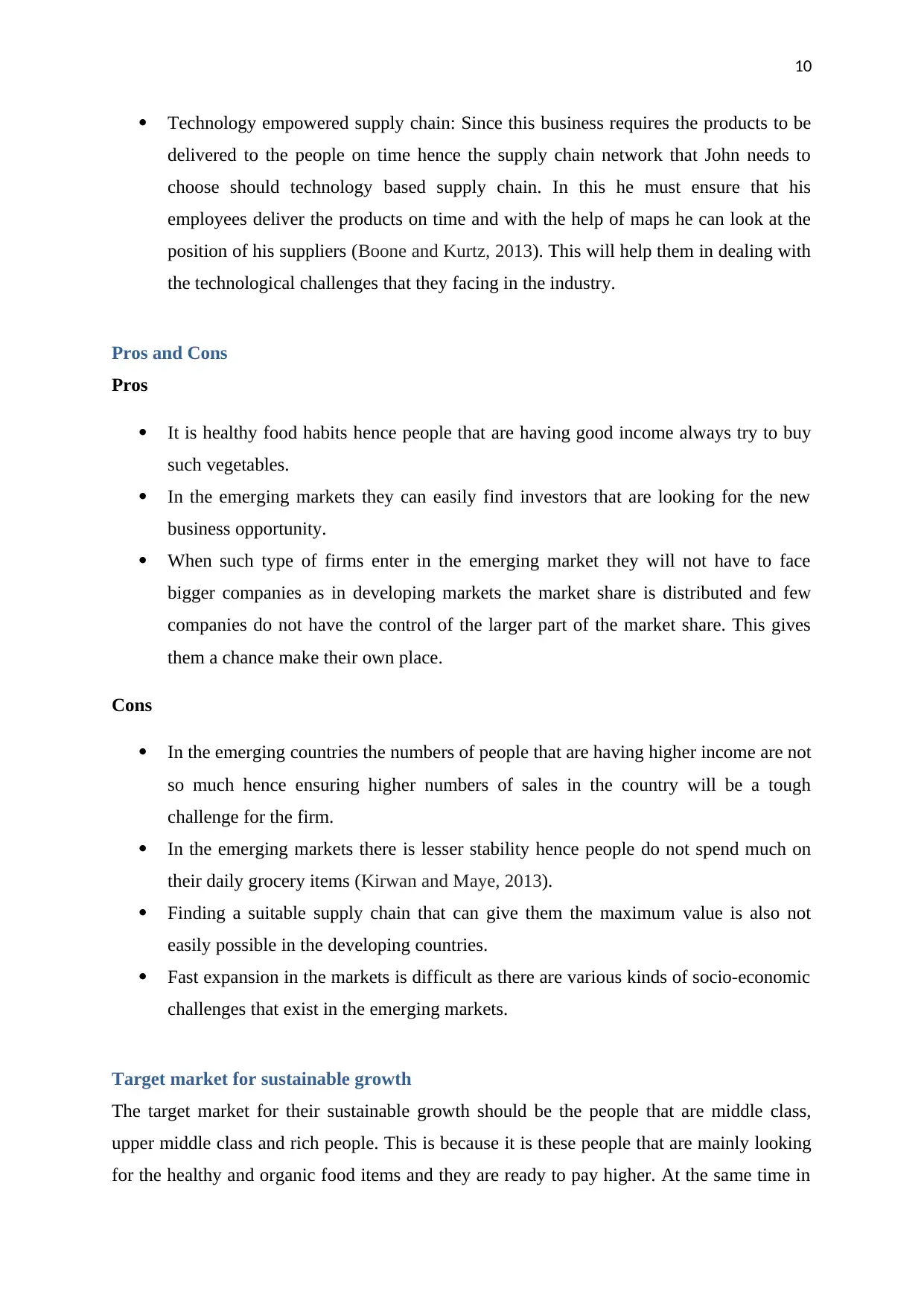
10
Technology empowered supply chain: Since this business requires the products to be
delivered to the people on time hence the supply chain network that John needs to
choose should technology based supply chain. In this he must ensure that his
employees deliver the products on time and with the help of maps he can look at the
position of his suppliers (Boone and Kurtz, 2013). This will help them in dealing with
the technological challenges that they facing in the industry.
Pros and Cons
Pros
It is healthy food habits hence people that are having good income always try to buy
such vegetables.
In the emerging markets they can easily find investors that are looking for the new
business opportunity.
When such type of firms enter in the emerging market they will not have to face
bigger companies as in developing markets the market share is distributed and few
companies do not have the control of the larger part of the market share. This gives
them a chance make their own place.
Cons
In the emerging countries the numbers of people that are having higher income are not
so much hence ensuring higher numbers of sales in the country will be a tough
challenge for the firm.
In the emerging markets there is lesser stability hence people do not spend much on
their daily grocery items (Kirwan and Maye, 2013).
Finding a suitable supply chain that can give them the maximum value is also not
easily possible in the developing countries.
Fast expansion in the markets is difficult as there are various kinds of socio-economic
challenges that exist in the emerging markets.
Target market for sustainable growth
The target market for their sustainable growth should be the people that are middle class,
upper middle class and rich people. This is because it is these people that are mainly looking
for the healthy and organic food items and they are ready to pay higher. At the same time in
Technology empowered supply chain: Since this business requires the products to be
delivered to the people on time hence the supply chain network that John needs to
choose should technology based supply chain. In this he must ensure that his
employees deliver the products on time and with the help of maps he can look at the
position of his suppliers (Boone and Kurtz, 2013). This will help them in dealing with
the technological challenges that they facing in the industry.
Pros and Cons
Pros
It is healthy food habits hence people that are having good income always try to buy
such vegetables.
In the emerging markets they can easily find investors that are looking for the new
business opportunity.
When such type of firms enter in the emerging market they will not have to face
bigger companies as in developing markets the market share is distributed and few
companies do not have the control of the larger part of the market share. This gives
them a chance make their own place.
Cons
In the emerging countries the numbers of people that are having higher income are not
so much hence ensuring higher numbers of sales in the country will be a tough
challenge for the firm.
In the emerging markets there is lesser stability hence people do not spend much on
their daily grocery items (Kirwan and Maye, 2013).
Finding a suitable supply chain that can give them the maximum value is also not
easily possible in the developing countries.
Fast expansion in the markets is difficult as there are various kinds of socio-economic
challenges that exist in the emerging markets.
Target market for sustainable growth
The target market for their sustainable growth should be the people that are middle class,
upper middle class and rich people. This is because it is these people that are mainly looking
for the healthy and organic food items and they are ready to pay higher. At the same time in
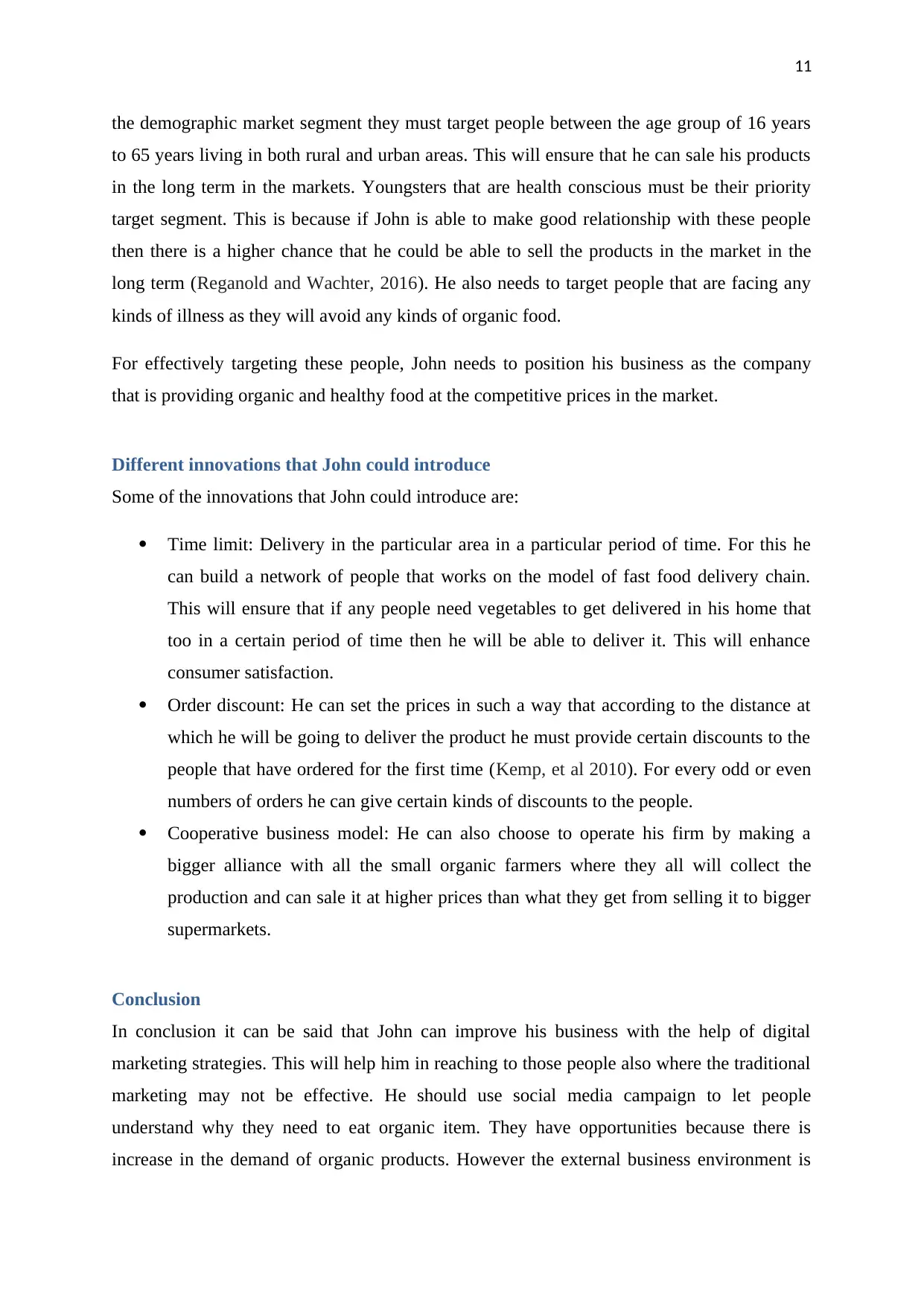
11
the demographic market segment they must target people between the age group of 16 years
to 65 years living in both rural and urban areas. This will ensure that he can sale his products
in the long term in the markets. Youngsters that are health conscious must be their priority
target segment. This is because if John is able to make good relationship with these people
then there is a higher chance that he could be able to sell the products in the market in the
long term (Reganold and Wachter, 2016). He also needs to target people that are facing any
kinds of illness as they will avoid any kinds of organic food.
For effectively targeting these people, John needs to position his business as the company
that is providing organic and healthy food at the competitive prices in the market.
Different innovations that John could introduce
Some of the innovations that John could introduce are:
Time limit: Delivery in the particular area in a particular period of time. For this he
can build a network of people that works on the model of fast food delivery chain.
This will ensure that if any people need vegetables to get delivered in his home that
too in a certain period of time then he will be able to deliver it. This will enhance
consumer satisfaction.
Order discount: He can set the prices in such a way that according to the distance at
which he will be going to deliver the product he must provide certain discounts to the
people that have ordered for the first time (Kemp, et al 2010). For every odd or even
numbers of orders he can give certain kinds of discounts to the people.
Cooperative business model: He can also choose to operate his firm by making a
bigger alliance with all the small organic farmers where they all will collect the
production and can sale it at higher prices than what they get from selling it to bigger
supermarkets.
Conclusion
In conclusion it can be said that John can improve his business with the help of digital
marketing strategies. This will help him in reaching to those people also where the traditional
marketing may not be effective. He should use social media campaign to let people
understand why they need to eat organic item. They have opportunities because there is
increase in the demand of organic products. However the external business environment is
the demographic market segment they must target people between the age group of 16 years
to 65 years living in both rural and urban areas. This will ensure that he can sale his products
in the long term in the markets. Youngsters that are health conscious must be their priority
target segment. This is because if John is able to make good relationship with these people
then there is a higher chance that he could be able to sell the products in the market in the
long term (Reganold and Wachter, 2016). He also needs to target people that are facing any
kinds of illness as they will avoid any kinds of organic food.
For effectively targeting these people, John needs to position his business as the company
that is providing organic and healthy food at the competitive prices in the market.
Different innovations that John could introduce
Some of the innovations that John could introduce are:
Time limit: Delivery in the particular area in a particular period of time. For this he
can build a network of people that works on the model of fast food delivery chain.
This will ensure that if any people need vegetables to get delivered in his home that
too in a certain period of time then he will be able to deliver it. This will enhance
consumer satisfaction.
Order discount: He can set the prices in such a way that according to the distance at
which he will be going to deliver the product he must provide certain discounts to the
people that have ordered for the first time (Kemp, et al 2010). For every odd or even
numbers of orders he can give certain kinds of discounts to the people.
Cooperative business model: He can also choose to operate his firm by making a
bigger alliance with all the small organic farmers where they all will collect the
production and can sale it at higher prices than what they get from selling it to bigger
supermarkets.
Conclusion
In conclusion it can be said that John can improve his business with the help of digital
marketing strategies. This will help him in reaching to those people also where the traditional
marketing may not be effective. He should use social media campaign to let people
understand why they need to eat organic item. They have opportunities because there is
increase in the demand of organic products. However the external business environment is
⊘ This is a preview!⊘
Do you want full access?
Subscribe today to unlock all pages.

Trusted by 1+ million students worldwide
1 out of 15
Related Documents
Your All-in-One AI-Powered Toolkit for Academic Success.
+13062052269
info@desklib.com
Available 24*7 on WhatsApp / Email
![[object Object]](/_next/static/media/star-bottom.7253800d.svg)
Unlock your academic potential
Copyright © 2020–2025 A2Z Services. All Rights Reserved. Developed and managed by ZUCOL.





